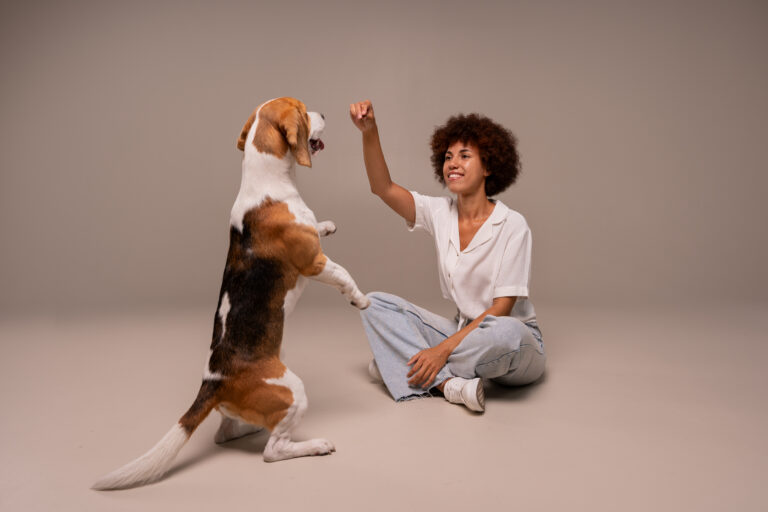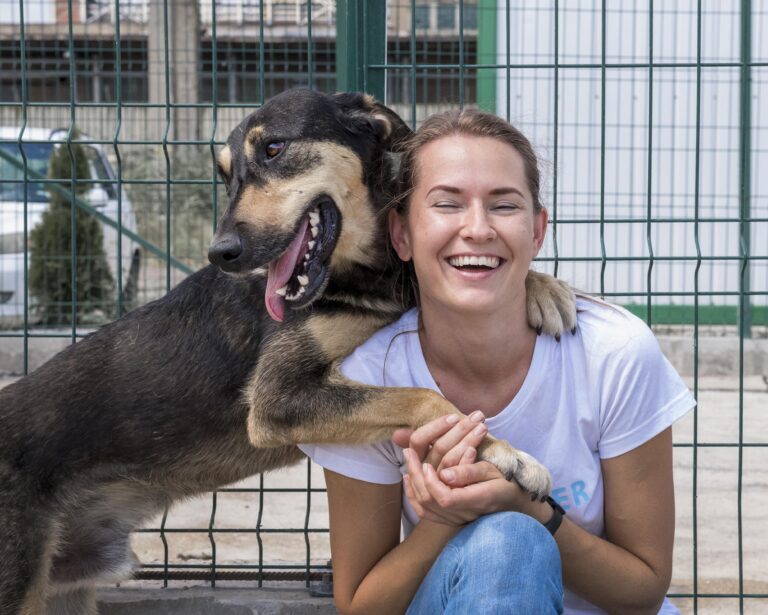The Role of Impulse Control in Distraction-Based Training in Dogs
Impulse Control in Distraction-Based Training is one of the most valuable skills your dog can develop. At the heart of this is dog patience—the ability to pause and think before reacting. Whether you’re passing other dogs, hearing loud noises, or training in busy areas, teaching your dog to stay calm and focused is essential. In this post, we’ll explore how impulse control improves training, strengthens your bond, and leads to better behavior in high-distraction environments.
Impulse control in dogs has its roots in concepts like delayed gratification and conditioned responses. Historically, training methods that include distractions have shown a 65% higher success rate when paired with rigorous impulse control exercises. By mastering impulse control, dogs become more focused and reliable, leading to an overall higher rate of training success in various environments.
Impulse control is essential in distraction-based training for dogs as it enhances focus and obedience. It involves teaching dogs to resist immediate reactions to distractions, leading to improved behavior and training success. Mastering impulse control ensures that dogs respond reliably to commands even in stimulating environments, fostering safer and more effective interactions.
The Role of Impulse Control in Distraction-Based Training in Dogs
Impulse control is crucial in dog training, especially when distractions are present. Dogs are naturally curious and can easily lose focus. Teaching them to manage their impulses helps them stay attentive. This is important for their safety and the effectiveness of their training. Without impulse control, training sessions can become chaotic and less productive.
Distraction-based training techniques involve introducing stimuli that can divert the dog’s attention. This could be anything from a toy to another dog. The goal is to help the dog learn to focus despite these distractions. As dogs improve their impulse control, they become better at ignoring these distractions. This makes them more responsive to commands and improves their overall behavior.
There are several methods to develop impulse control in dogs. One popular method is the “leave it” command, which teaches dogs to ignore certain objects or distractions. Another technique is the “wait” command, which encourages dogs to pause before receiving a treat or toy. Consistent practice of these commands helps reinforce impulse control. Over time, dogs learn to apply these skills in various situations.
Effective impulse control training benefits both dogs and their owners. Dogs that can manage their impulses are generally calmer and more obedient. They are also less likely to engage in undesirable behaviors such as jumping on guests or chasing after cars. For owners, this means less stress and more enjoyable interactions with their pets. Ultimately, impulse control training enhances the bond between dogs and their owners.
Defining Impulse Control and Its Importance in Training
Impulse control in dogs is the ability to delay immediate reactions to various stimuli. This means a dog can wait, even when it sees something exciting or tempting. Teaching impulse control is part of dog training and involves consistency and patience. For example, a dog learns to sit calmly before crossing the street. This mindset keeps dogs safe and obedient.
Training with impulse control helps dogs become well-behaved family members. When dogs can manage their impulses, they don’t jump on guests or chase after other animals. This makes them easier to live with and take out in public. Owners experience fewer problems and have more pleasant times with their pets. This training builds a stronger bond between the dog and owner.
Impulse control is essential for more complex training tasks. For instance, it helps in agility training where dogs need to follow a set course without getting distracted. In service dog training, impulse control ensures the dog can perform tasks reliably, regardless of the environment. This skill is crucial for dogs who have important roles in helping humans. Therefore, mastering impulse control is foundational for advanced training.
A lack of impulse control can lead to undesired behaviors. Dogs might bolt out the door or snatch food off the table. Both can be dangerous and frustrating for owners. Training sessions that incorporate impulse control significantly reduce these risks. By practicing and reinforcing these behaviors, dogs become safer and more enjoyable companions.
Methods to Develop Impulse Control in Dogs
Developing impulse control in dogs starts with consistent practice and clear commands. One effective method involves using the “leave it” command, teaching the dog to ignore tempting objects. This can be practiced with toys, food, or anything the dog finds interesting. Gradually increasing the difficulty of objects enhances the training. Over time, the dog learns to resist immediate impulses.
The “wait” command is another technique that builds impulse control. Dogs are instructed to pause before receiving reward items such as treats or toys. This teaches patience and self-control. The command can be practiced daily during mealtime or playtime. It reinforces the dog’s ability to stay calm and composed.
Incorporating varied exercises like sitting before going outside or staying still before car rides can also help. These moments provide opportunities to practice impulse control in real-life situations. Consistent reinforcement is key to making these exercises effective. Owners should reward their dogs for successfully managing impulses. This encourages positive behavior.
Advanced methods include structured training sessions with specific goals. Using these sessions, owners can introduce complex scenarios where impulse control is critical. Training with distractions, like loud noises or other animals, challenges the dog’s focus. This can improve their ability to remain calm under pressure. Strengthening impulse control enhances overall training success.
Examples of Distraction-Based Training Techniques
One widely used distraction-based training technique is the “look at me” exercise. This involves calling the dog’s name and rewarding them when they make eye contact. It shifts the dog’s focus from the distraction to the owner. Repeating this exercise in different environments solidifies this response. Over time, the dog learns to seek the owner’s attention amidst distractions.
Another effective method is practicing obedience commands in increasingly distracting environments. Start with a quiet space and gradually introduce more distractions, such as other dogs or loud noises. This gradual increase helps the dog adapt and maintain focus. Commands like “sit” or “stay” become more reliable. Consistency in varied settings is key to success.
Using toys or treats as controlled distractions can also be beneficial. Place the treat or toy within sight but out of reach, instructing the dog to ignore it. Reward the dog when it follows the command without lunging for the object. This helps the dog resist impulses and strengthens their training. It also adds an element of challenge.
Group training classes are another method to enhance distraction-based training. Dogs practice commands around other dogs and people, learning to focus despite the activity around them. This social setting mimics real-life scenarios. Owners can gauge their dog’s progress and address specific challenges. Group classes provide structured and supportive environments.
Incorporating real-world distractions, like practicing recall commands at a park, is also useful. The variety of sights, sounds, and smells in parks make it an excellent training ground. Dogs learn to listen and respond in diverse settings. This builds confidence and trust between the dog and owner. Real-world practice ensures skills are applicable in everyday life.
Benefits of Enhanced Impulse Control for Dog Behavior
Dogs with good impulse control are typically calmer and less reactive to their surroundings. This means they are less likely to bark at every noise or jump on guests. Enhanced impulse control helps create a more peaceful home environment. Owners notice improved obedience in their dogs. This makes everyday life smoother and more enjoyable.
Improved impulse control also leads to safer behaviors. Dogs are less likely to dart out into traffic when they learn to wait for a command. This reduces the risk of accidents or injuries. It also means dogs can enjoy more freedom outdoors. Safety becomes a less overwhelming concern.
Enhanced impulse control positively impacts other areas of training. Dogs that can manage their impulses are more responsive to advanced commands. This includes training for agility, obedience competitions, and service roles. The foundation of impulse control makes it easier to teach new skills. Owners can confidently progress to more challenging tasks.
Impulse control also promotes better social interactions. Dogs that wait patiently rather than jumping or nipping make better impressions. They can be taken to public places like parks and cafes more comfortably. Social events and outings become less stressful for both dog and owner. Positive experiences boost the dog’s overall confidence.
Finally, impulse control strengthens the bond between dogs and their owners. Consistent training and positive reinforcement build trust. Dogs learn that staying calm brings rewards and praise. Owners appreciate the improved behavior and reliability. This mutual understanding enhances their relationship.
Challenges and Considerations in Training Regimes
Training regimes can be challenging due to various factors. One major hurdle is consistency; it can be tough for owners to maintain regular training sessions. A dog’s progress can stall if consistent practice is not given. This inconsistency can confuse the dog. Maintaining a schedule is vital for effective training.
Another consideration is the dog’s individual temperament. Some dogs may be more stubborn or easily distracted. These traits can make training more difficult. Adjusting methods to suit the dog’s personality is essential. Training should be flexible to meet the dog’s specific needs.
External environment plays a significant role in training. Distractions like other animals, noises, or new smells can disrupt focus. Finding a controlled environment for initial training is helpful. As the dog progresses, gradually introducing distractions can be beneficial. This approach helps the dog adapt.
Physical limitations of the dog can also affect training. Older dogs or those with health issues may need modified exercises. It’s important to consider the dog’s physical capabilities. Avoiding actions that can cause strain or injury is crucial. Tailoring training to the dog’s health ensures safety.
Owner’s patience and attitude significantly impact training outcomes. Frustration or impatience can negatively affect the dog. Maintaining a positive and encouraging environment helps motivate the dog. Rewarding progress, no matter how small, fosters better results. A supportive approach strengthens the training bond.
Frequently Asked Questions
Distraction-based training techniques require dogs to manage impulses and maintain focus. Here are some commonly asked questions about this approach and how it benefits dogs and trainers.
1. Why is impulse control important for dogs?
Impulse control is vital because it helps dogs respond consistently to commands. Without it, dogs may act on impulses like chasing cars or barking at visitors. This can lead to unsafe situations for both the dog and others.
With good impulse control, dogs learn to pause and think before reacting. This skill is beneficial for all types of training and everyday interactions. It makes dogs more manageable and fosters a safer, happier environment.
2. What are some common techniques to teach impulse control?
Several techniques can teach dogs impulse control, including the “leave it” and “wait” commands. These methods involve instructing the dog to ignore distractions or pause before getting a treat. Practicing these commands regularly can help reinforce the desired behavior.
Using toys or treats as controlled distractions is another effective method. Gradually increasing the difficulty of these exercises can help dogs better manage their impulses. Consistency and patience are key to success.
3. How does impulse control benefit a dog’s behavior in public?
Dogs with good impulse control behave better in public settings. They are less likely to jump on strangers or react aggressively to other dogs. This makes outings more enjoyable and less stressful for both the dog and the owner.
Impulse control also ensures that dogs can be trusted in various situations. Owners can feel confident taking their pets to parks, cafes, and social events. Well-behaved dogs can interact positively with more people and animals.
4. Can older dogs learn impulse control?
Yes, older dogs can learn impulse control with proper training. While it may take more time and patience, older dogs are capable of learning new behaviors. Using consistent training methods and positive reinforcement can yield good results.
It’s important to consider any physical limitations that older dogs might have. Tailoring training exercises to suit their needs ensures safety and effectiveness. With dedication, older dogs can enjoy the benefits of impulse control.
5. What role do professional trainers play in teaching impulse control?
Professional trainers bring expertise and experience to teaching impulse control. They can assess a dog’s specific needs and develop tailored training plans. Trainers also provide guidance and support to dog owners, ensuring consistency in training.
Working with a professional can accelerate the learning process for both dogs and owners. Trainers introduce advanced techniques and scenarios that might be challenging to implement alone. This professional support enhances the overall success of the training program.

Conclusion
Impulse control is a fundamental aspect of effective dog training, especially in distraction-based methods. By mastering this skill, dogs not only enhance their ability to focus but also improve their overall behavior and safety. This leads to more harmonious interactions between dogs and their owners.
Training for impulse control requires consistent practice, patience, and often professional guidance. The benefits are significant, from safer public outings to better obedience in various situations. Investing time in impulse control training strengthens the bond between dogs and their owners, creating a more enjoyable and fulfilling relationship.








